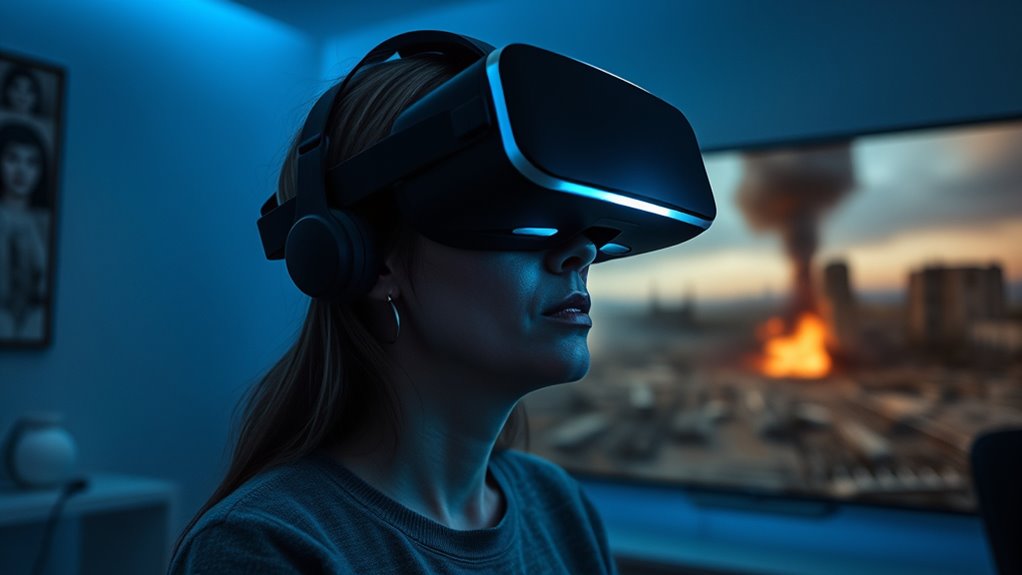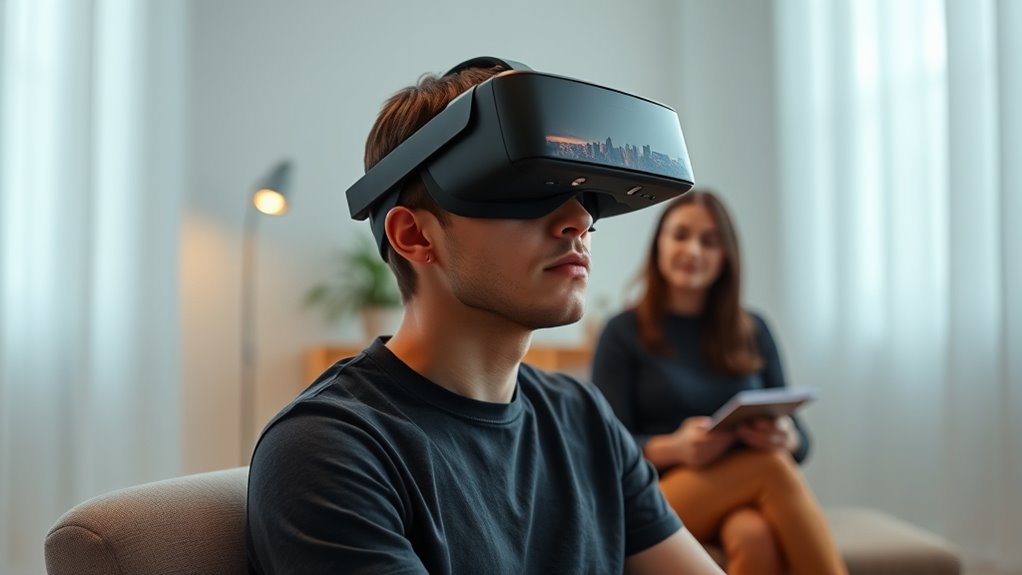Virtual reality therapy helps treat PTSD more effectively by immersing you in realistic environments that allow safe confrontation of traumatic memories. It engages multiple senses, making experiences feel vivid and real, which enhances emotional and cognitive processing. This personalized approach reduces symptoms like flashbacks and hypervigilance more rapidly than talk therapy alone. With tailored scenarios and gradual exposure, VR therapy promotes neural changes supportive of recovery. To discover how this innovative method can transform your healing journey, keep exploring the details.
Key Takeaways
- VR therapy provides immersive, realistic scenarios that enhance emotional engagement and facilitate more effective trauma processing than talk therapy alone.
- Multi-sensory stimulation in VR deepens neural connections, improving emotional regulation and reducing PTSD symptoms more efficiently.
- Personalized VR environments tailor exposure levels, increasing safety and comfort, leading to better treatment adherence and outcomes.
- The controlled, gradual exposure in VR helps diminish intrusive memories and hypervigilance more effectively than traditional discussion-based therapy.
- Integration of additional techniques and cultural sensitivity in VR enhances engagement and addresses individual needs, boosting overall treatment success.

Virtual reality therapy is transforming how we treat PTSD by immersing patients in controlled, realistic environments that simulate traumatic experiences. Through this approach, you can confront your memories in a safe, structured setting, which helps reduce the power these memories hold over you. Unlike traditional talk therapy, VR creates an immersive exposure that lets you relive aspects of your trauma without actual danger, making the process more effective and less overwhelming. This immersive exposure is carefully calibrated by therapists to gradually increase your comfort level, helping you confront fears incrementally rather than feeling flooded all at once.
VR therapy immerses you in safe, controlled environments to gradually confront trauma and reduce its emotional hold.
A key advantage of virtual reality therapy lies in its ability to enhance sensory integration. When you wear VR headsets, your brain receives multi-sensory inputs—visual, auditory, and sometimes even tactile stimuli—that mimic real-life trauma scenarios. This multisensory engagement helps your brain process memories more holistically, leading to better emotional regulation and cognitive restructuring. You’re not just talking about your trauma; you’re experiencing it in a controlled way, which can deepen your understanding and reduce avoidance behaviors.
By engaging multiple senses simultaneously, VR therapy creates a more vivid and realistic experience that traditional exposure therapy may lack. This heightened realism helps you stay engaged and focused, making it easier for your therapist to guide you through the process. The sensory integration involved can also facilitate stronger neural connections associated with memory and emotion, enabling your brain to reframe traumatic events more effectively. Over time, this can diminish the intensity of your PTSD symptoms, such as flashbacks, hypervigilance, and intrusive thoughts.
Because virtual reality environments can be customized, your therapist can tailor each session to your specific needs, gradually increasing the complexity of scenarios as your resilience builds. This personalized approach ensures you’re not overwhelmed and allows you to process trauma at a pace that feels manageable. Additionally, VR therapy offers a safe space where you can confront fears without actual risk, which encourages more openness and participation. Furthermore, incorporating tuning techniques from related Hyundai models demonstrates how precise adjustments can optimize performance, paralleling how VR therapy fine-tunes exposure levels to suit individual progress.
Research shows that integrating cultural intelligence strategies into therapy can also improve patient engagement and outcomes by addressing individual cultural backgrounds, making treatment more effective and respectful of personal differences.
Frequently Asked Questions
How Long Does Each VR Therapy Session Typically Last?
You might wonder about session duration and therapy scheduling for VR therapy. Typically, each VR therapy session lasts about 30 to 60 minutes, depending on your needs and progress. Therapists usually schedule these sessions weekly or bi-weekly, allowing enough time to process experiences. The length and frequency can vary, but the goal is to balance effective treatment with your comfort, ensuring steady progress without overwhelming you.
Are There Any Risks or Side Effects Associated With VR Therapy?
You might worry about Virtual Reality safety, but most side effects are mild and manageable. Common concerns include dizziness or nausea, which often subside quickly with proper side effect management. Therapists carefully monitor your response during sessions, ensuring your comfort and safety. While rare, some individuals may experience temporary emotional distress. Overall, VR therapy is safe, and any risks are minimized through professional oversight, making it a promising PTSD treatment.
How Does VR Therapy Compare to Traditional Exposure Therapy?
When comparing VR therapy to traditional exposure therapy, you experience enhanced virtual immersion and sensory engagement, making exposure more realistic and controlled. This technology allows you to confront traumatic memories safely, often leading to quicker progress. Unlike talk therapy, VR immerses you directly in scenarios, helping you process emotions more effectively. So, VR therapy offers a more engaging, targeted approach that can improve outcomes for PTSD treatment.
Can VR Therapy Be Used Alongside Medication for PTSD?
You might find it surprising, but VR therapy can indeed be combined with medication for a powerful treatment synergy. This combined treatment approach allows you to benefit from immersive exposure therapy while managing symptoms with medication. Using VR alongside medication offers a more thorough strategy, addressing both psychological and physiological aspects of PTSD. Always consult your healthcare provider to guarantee this integrated approach suits your specific needs and circumstances.
Is VR Therapy Effective for All Types of PTSD?
You might wonder if Virtual Reality (VR) therapy works for all types of PTSD. While VR is a versatile tool in PTSD treatment, its effectiveness can vary depending on individual experiences and trauma specifics. For some, VR provides immersive exposure that helps reduce symptoms. However, it’s not a one-size-fits-all solution, and a mental health professional can determine if VR therapy suits your particular PTSD type.
Conclusion
Virtual reality therapy offers a powerful tool, like a bridge, guiding you through your trauma in a safe and controlled environment. It allows you to confront memories head-on, making healing more effective than talk alone. As you navigate this innovative approach, you’ll find it’s not just therapy, but a journey towards reclaiming control. Embrace this technology, and watch your path to recovery become clearer, brighter, and more achievable than ever before.
Amina brings over a decade of journalism experience to her role as Editor-in-Chief. Under her leadership, Exquisite Post has flourished, maintaining the highest standards of integrity and excellence. Amina’s commitment to truth and her visionary approach guide the editorial team in producing impactful news stories that resonate with our audience.










